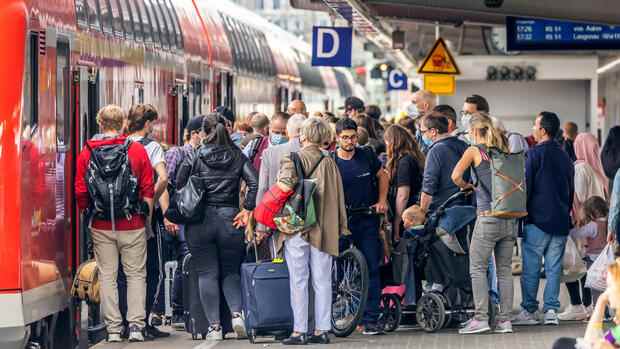Berlin The nine-euro ticket ensures that people leave their cars at home more often than previously thought. At least that is the result of the market research by the Association of German Transport Companies (VDV) for July, which is available to the Handelsblatt. However, there are inconsistencies in the figures. The association coordinates the surveys on behalf of the federal and state governments.
The VDV reacted. The market researchers had made a “sharpening of the answers” “in order to rule out suspected misunderstandings among the respondents”. The result for July is now: “The almost daily intensity of use of cars/motorcycles has fallen by four percentage points compared to May 2022. Ten percent (June: eight percent) of those who bought the nine-euro ticket now do without at least one of their daily tickets car rides.”
Top jobs of the day
Find the best jobs now and
be notified by email.
1.8 million tons less carbon dioxide?
However, the result does not mean that there were ten percent fewer car journeys because of the discount ticket. Rather, it is at most the assumed four percent, although there was no survey at all in May – before the introduction of the nine-euro ticket. And yet: In order to determine the climate effect, the market researchers assume in their estimate “around ten percent shifted trips” from cars to local transport and also “around 50 kilometers per trip”. They then relate the ten percent to the “around one billion trips per month”.
When asked, the association explains that the ten percent refers to the nine-euro ticket buyers who left the car for it. “And from market research, the 50 kilometers are the average distance traveled by trips that were shifted from the car.”
Presented in red letters, the surprising result for the three months in which the ticket is offered is: “Savings of around 1.8 million tons of carbon dioxide during the campaign period”. To do this, the researchers assumed average car emissions of 122 grams per kilometer. Calculated over the year, 7.2 million tons of CO2 could be saved with the nine-euro ticket.
For comparison: According to experts, a general speed limit of 130 kilometers per hour on motorways should help to save two million tons a year.
What’s more, last year the transport sector emitted three million tons more than the law allows. With an immediate program, Minister Volker Wissing (FDP) must now save this amount in the years to come, plus another six million tons for this year alone, making a total of nine million tons.
Nine-euro ticket: costs ten billion euros per year
According to the findings of the market researchers, the nine-euro ticket would be of great help in achieving the climate targets. This would cost ten billion euros per year – money that the federal states and local transport companies would like to have from the federal government.
But the assumptions have to be right. Until now, local transport – with a significantly improved range of routes and vehicles – was assumed to have a far lower climate impact. It was less than a million tons a year, as determined by a government commission in the last election period.
The success of the discount campaign depends largely on whether significantly more people leave their cars at home and use local transport. According to the market researchers, the proportion of trips shifted from another mode of transport to local transport was “significantly higher than the calculation in June” and was 17 percent in the first week of August.
This also includes environmentally friendly modes of transport such as cycling and running. And the proportion of journeys that would not have taken place without the cheap ticket is lower than previously thought. According to the market researchers, it is 15 percent.
Only around ten percent surveyed new customers
At the end of March, the federal government decided to introduce a uniform low-cost ticket for local transport and thus relieve people of their mobility costs. Since things had to be done quickly, the government asked the VDV to accompany the experiment with market research. The association asked the member company Deutsche Bahn AG to commission its market researchers from Forsa and Research & Consulting GmbH.
According to their information, 6,000 people are surveyed representatively every week. From June to August there should be 78,000 respondents, in July there were 11,837. According to their own statements, the market researchers asked 783 users about the question of not using other means of transport; their information was “weighted with the frequency of trips per person” and was therefore “representative”. Of these, only around ten percent were new customers.
As the VDV reported in its circular to members, there were extrapolated “at least 30 million people (including subscribers) who owned a nine-euro ticket in July”. One in five buyers is a “new customer” who has normally never used local public transport before. Another 27 percent are “activated customers” who previously used public transport less than once a month. The ticket is mainly bought in cities. According to the survey, the offer in rural areas is often insufficient.
Two-thirds of those surveyed use the ticket primarily on longer journeys. However, 19 percent also stated that they were now driving less again because buses and trains had become too crowded on certain routes.
More: Consumer advocates: Passengers should pay at the earliest on departure
